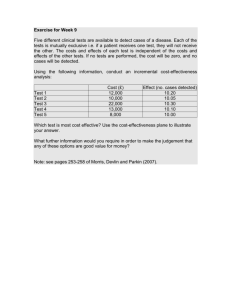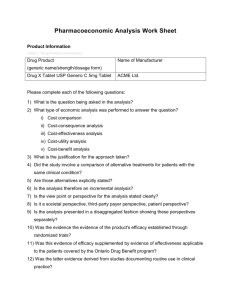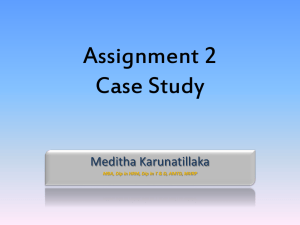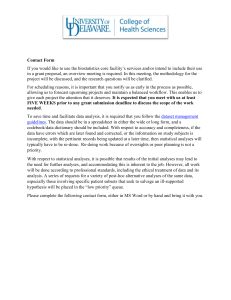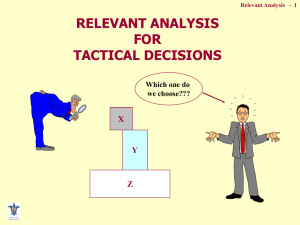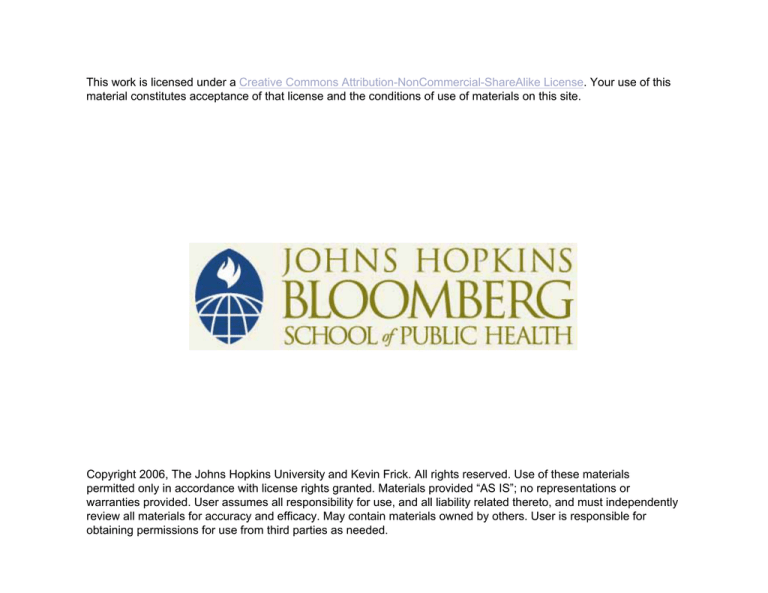
This work is licensed under a Creative Commons Attribution-NonCommercial-ShareAlike License. Your use of this
material constitutes acceptance of that license and the conditions of use of materials on this site.
Copyright 2006, The Johns Hopkins University and Kevin Frick. All rights reserved. Use of these materials
permitted only in accordance with license rights granted. Materials provided “AS IS”; no representations or
warranties provided. User assumes all responsibility for use, and all liability related thereto, and must independently
review all materials for accuracy and efficacy. May contain materials owned by others. User is responsible for
obtaining permissions for use from third parties as needed.
Recommendations of the Panel on CostEffectiveness in Health and Medicine
Kevin Frick, PhD
Johns Hopkins University
Section A
What a Reader of a CEA
Should See
History of the Panel
Established to support the conduct and interpretation
of cost-effectiveness studies in prevention
Ë Eventually expanded to CEA in general
Improve and standardize methodology
Set of guidelines were called a “reference case”
While guidelines help, the field continues to develop
and debates continue to occur
4
Framework
Background of the problem
General framing and design of the analysis
Target population for the intervention
Other program descriptors
Description of comparator programs
Boundaries of the analysis
Statement of the perspective of the analysis
5
Data and Methods
Description of the “event pathway”
Identification of outcomes of interest
Description of the model used
Modeling assumptions
Continued
6
Data and Methods
Description of the “event pathway”
Identification of outcomes of interest
Description of the model used
Modeling assumptions
Continued
7
Data and Methods
Diagram of “event pathway”/model
Software used
Complete information of sources of effectiveness
data, cost data, preference weights
8
More on Data and Methods
Methods for obtaining estimates of effectiveness,
cost, and preferences
Critique of data quality
Statement of year of costs
Statement of method used to adjust costs for
inflation
Continued
9
More on Data and Methods
Statement of type of currency
Source and methods for obtaining expert judgment
Statement of discount rates
10
Results
Results of model validation
Reference case results
Ë Discounted and undiscounted
Ë Total costs and effectiveness
Ë Incremental costs and effectiveness
Ë Incremental cost-effectiveness ratios
Results of sensitivity analyses
Continued
11
Results
Results of model validation
Reference case results
Ë Discounted and undiscounted
Ë Total costs and effectiveness
Ë Incremental costs and effectiveness
Ë Incremental cost-effectiveness ratios
Results of sensitivity analyses
12
More about Results
Other estimates of uncertainty, if available
Graphical representation of results
Aggregate cost and effectiveness information
Disaggregated results, as relevant
Secondary analyses using 0% and 5% discount rates
Other secondary analyses, as relevant
13
Discussion
Summary of reference case results
Summary of sensitivity of results to assumptions and
uncertainties in the analysis
Discussion of analytic assumptions with important
ethical implications
Limitations of the study
Relevance of study results for specific policy
questions or decisions
14
More Discussion Points
Results of related cost-effectiveness analyses
Ë Reporting on the previous literature
Distributive implications of an intervention
Ë Are there winners and losers?
15
Section B
Panel on Cost-Effectiveness Recommendations
Alternatives for Comparison
The list of alternative strategies should include all
reasonable options and a baseline comparison
Continued
17
Alternatives for Comparison
The definition of all reasonable is a non-negligible
issue
Ë Should it be anything that can be dreamed up?
Ë Should it be alternatives that are politically
feasible?
Ë Should it be limited to alternatives within a
fixed budget?
18
Perspective
Report Societal Perspective
Others may be the primary reason for undertaking a
study
Ë Show the analysis from the perspective that is
the primary function
Continued
19
Perspective
Also Show the Societal Perspective
Having a portfolio of societal perspective studies will
make it easier to compare across disease areas or
treatments
20
What to Include in a Societal Perspective?
All measurable opportunity costs, representing all
groups affected by a program, should be included in
the societal perspective
Ë Opportunity cost is often approximated by the
market price
Ë The technical definition is the value of the next
best alternative use of the resources
21
Time Frame and Horizon
Capture the length of the program and the time
during which all costs, harms, and benefits occur
Ë A program preventing under five mortality
should be evaluated considering the five years
of implementation during which mortality is to
be prevented and the remainder of the lifetime
of the children who do not die as a result of the
program
22
How to Characterize Costs and Effects?
Costs can be referred to as average, incremental, or
marginal
An average cost-effectiveness analysis would
compare all alternatives to doing nothing or the least
expensive to get an average cost per better outcome
gained
Continued
23
How to Characterize Costs and Effects?
Incremental analysis focuses on the cost per outcome
for an alternative in comparison to the next most
expensive and effective
Marginal analysis focuses on increasing the size of a
program a small amount
24
How Comprehensive Should the Analysis Be?
Include all benefits and harms that have a meaningful
impact on the results
Ë Costs and effects may vary greatly or vary
slightly
Continued
25
How Comprehensive Should the Analysis Be?
Include all benefits and harms that have a meaningful
impact on the results
Ë Costs and effects may be large or small in
magnitude
x Highly variable and large in magnitude
should be included
x Little variation and small in magnitude
can be excluded
x Others must be considered individually
26
Sensitivity Analyses
Univariate
Change the value of one variable used in the analysis
and see what happens to the results
Continued
27
Sensitivity Analyses
Multivariate
Change the value of more than one variable at a time
and see what happens to the results
Ë Many variations on how to change the values of
multiple variables in order to get some idea of
how stable the results are
28
Implications of the Results
Distributional
Ë Who has higher costs?
Ë Who saves money?
Ë Who has better outcomes?
Ë Does anyone have worse outcomes?
Continued
29
Implications of the Results
Ethical
Ë Are the effects distributed in a way that is fair?
Ë How do the results match with standard ideas
of values and ethics?
30
What Should be Explicit?
All assumptions
All sources of information
31
Incidence-Based Costs
Costs of a disease starting from the onset and
continuing for the remainder of the person’s life
Not all the costs are associated with a condition in a
given year
32
Cost Methods
Resource value rather than charges if they are
different
Human capital approach to estimate productivity
costs
33
Health Utility Values
Utility assessment should be preference-based and
interval scaled on a scale with optimal health equal to
one and death equal to zero
Generic health instrument
Community-based scoring algorithm
34
Discounting
Discount future costs and health
Discount both future costs and health at same rate
Use discount rate of 3% with sensitivity analyses over
a reasonable range, especially 0% and 5%
35
Measures
For CBA, capture all costs and benefits and report a
net benefit
Use final health outcome measures in a CEA
The numerator should include only direct costs unless
the quality of life instrument in the denominator does
not include indirect costs
Continued
36
Measures
QALY measure should rely on community preferences
and preference based weights that use an interval
scale
37
Final Recommendations
The numerator of a CEA should include costs of the
intervention, adverse health outcomes, and health
outcomes averted by the intervention
Ë Medical, non-medical, possibly productivity
Report total costs, total effect, incremental costs,
incremental effects, and incremental costeffectiveness ratios
38
Section C
Panel on Cost-Effectiveness Recommendations
in Action
Healthy Start: Background
Program set up in most socioeconomically
disadvantaged areas of the city
Neighborhood canvassing for expectant mothers
Case management during pregnancy
Follow-up for mother, father, and children after
pregnancy until children turn three
40
Healthy Start: Problems Being Addressed
Avoiding very low birth weight
Help mother to get her life in order
Ë Complete education
Ë Get a job
Ë Avoid interaction with criminal justice system
Ë Better parenting (less abuse and neglect)
Ë Become economically independent
41
Healthy Start: Problems Being Addressed
Help fathers
Ë Similar list of issues as for mothers
Ë Emphasize playing a role in children’s lives
42
Healthy Start Data
Very low birth weight
Ë Easily tracked
Effects of very low birth weight
Ë No link to Medicaid
Ë No plan (when program began) to link up with
data for child abuse or early education
programs
Continued
43
Healthy Start Data
Follow-up data on mothers and fathers other than
simple administrative data was quite limited
44
Healthy Start Time Horizon
Time Horizon
Appropriateness
Data
Availability
One Year
Three Years
Lifetime
45
Healthy Start Perspective
Perspective
Appropriateness
Data
Availability
Government
(Levels???)
Mothers
Society
Continued
46
Healthy Start Perspective
Perspective
Appropriateness
Data
Availability
Government
(Levels???)
Mothers
Society
47
Healthy Start Summary
Most readily available data and literature sources to
look at one year costs related to very low birth weight
avoided from a governmental perspective
Very low birth weight occurs in only 4% of the
population at risk even without an intervention
Continued
48
Healthy Start Summary
Significant reduction in very low birth weight
However, even with an expensive condition like
VLBW, the costs exceeded the benefits
49
Healthy Start Sensitivity Analyses
Consider longer time periods
Think about other potential benefits
Treat as a cost-effectiveness analysis where the
governmental calculations really represent only the
numerator of the cost-effectiveness analysis
50

